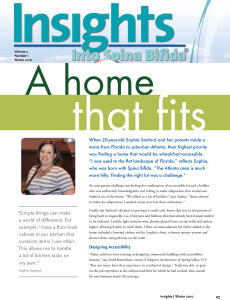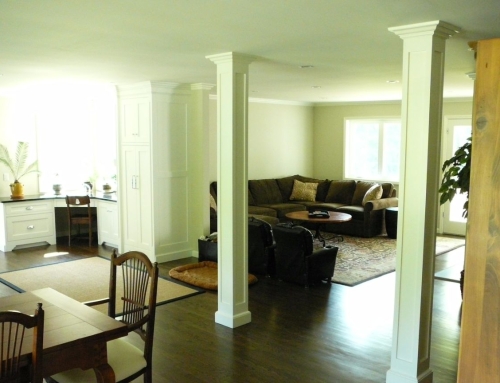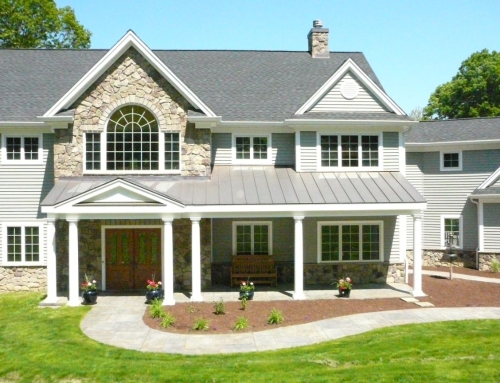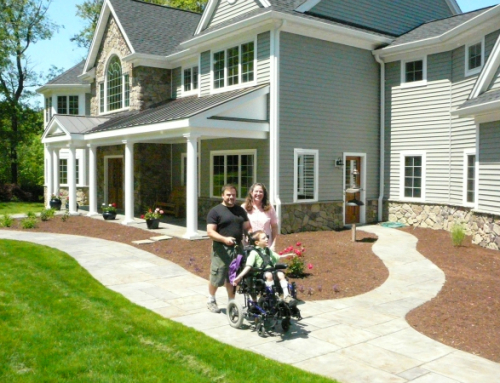When 20-year-old Sophia Sanford and her parents made a move from Florida to suburban Atlanta, their highest priority was finding a home that would be wheelchair-accessible. “I was used to the flat landscape of Florida,” reflects Sophia, who was born with Spina Bifida. “The Atlanta area is much hillier. Finding the right lot was a challenge.”

This article was reprinted from Insights Into Spina Bifida®, the Spina Bifida Association’s national magazine. To download a PDF click here.
An even greater challenge was finding the combination of an accessible lot and a builder who was sufficiently knowledgeable and willing to make adaptations that would ease Sophia’s use of the home. “We talked to a lot of builders,” says Sophia. “Some refused to make the adaptations I needed; many were less than enthusiastic.”
Finally the Sanford’s decided to purchase a ranch-style home that was in the process of being built in Loganville, Ga. Doorways and hallways that had already been framed needed to be widened. Luckily, light switches were already placed lower on the walls and outlets higher, allowing Sophia to reach them. Other accommodations her father added to the home included a lowered clothes rod for Sophia’s closet, a shower sprayer system and shower chair, and grab bars on the toilet.
Designing Accessibility
“Many architects have training in designing commercial buildings with accessibility features,” says Todd Rosenblum, owner of Adaptive Architecture of Spring Valley, N.Y. “But not many have that experience in residential design.” Todd was able to gain on-the-job experience at the architectural firm for which he had worked, then started his own business nearly 20 years ago.
“I’ll never forget my first client,” Todd recalls. “Because of an industrial accident, he was in a long term care facility—and his family wanted to bring him home desperately. His home had to accommodate 24/7 nursing care and visits from his doctor four times weekly.” There were few guidelines for Todd to consult. He did his own research, and spent a lot of time with his client. “Visiting the client in his existing situation is essential—I can see the barriers to his independence,” says Todd. “I also talk to everyone I can—family members, doctors, nurses, physical therapists, and teachers.”
Historically, homes were built to accommodate an average-sized, typically-abled person. As improved medical and trauma care has allowed more disabled people to live longer lives, adaptations that enhance accessibility of homes have become more popular. The wave of the future is “universal design,” a home design that people of any ability will find easy to negotiate. “Wider doorways and halls are not a barrier to anyone,” Todd observes. “In fact, people without a current disability may discover the need for those very design features as they age.”
An advantage to designing a home for accessibility from the outset is appearance. Adaptive Architecture does not use ramps, inside or out in new construction projects. If a client chooses to build a multi-level home, an elevator is installed. “No one driving by one of my homes will say, ‘That’s an accessible home,’” says Todd. “These are homes that re-sell easily to people without disability.” Photographs of some Adaptive Architecture homes are available for view at www.adaparch.com.
Todd warns that even a universal design is not a “one-size-fits-all” solution. Custom accommodations that are specific to an individual’s needs and abilities can enhance her comfort and independence in the home. “Simple things can make a world of difference,” agrees Sophia. “I have a floor-level cabinet in our kitchen that contains items I use often. This allows me to handle a lot of kitchen tasks on my own.”
This Sounds Expensive
“The cost to custom-design an accessible home versus a conventional home is about the same,” says Todd. Drawings may need to be more detailed, especially if the builder does not have experience with this kind of building. And depending on the equipment used in the home, such as elevators or ceiling lifts, the cost of building may exceed that of a conventional home. “People think they’ll save money by adapting or adding on to their existing home, but it may actually be cheaper to start fresh,” Todd explains. He suggests working with an architect that can prepare a feasibility study that can make those decisions easier.
“My parents were on a tight budget,” Sophia says. “It was a long process and took lots of digging, but we were able to find a home and a builder that worked for us.” A student in criminal justice, Sophia has plans to someday build her own accessible home. “I know it won’t be easy—the world is not generally accessible. But because of my experience with this house, I will be better prepared to make it happen.”
Choosing a Professional
Todd offered this advice about choosing an architect or contractor: “Check out their track record. Have they done this kind of work before? Find someone who pays attention to detail, listens to you, and does the necessary research. As one of my projects is being built, I watch over it to make sure it’s being done right.”
Sophia and her parents found choosing a builder to be the most important decision they had to make. “Don’t give up or get frustrated,” she recommends. “Get a lot of different opinions, and ask about what options are available. Builders don’t always advertise all the options. And don’t be afraid to speak up. The accommodations you are asking for are requirements for you, not requests.”
“This is such a rewarding business,” Todd concludes. “At the end of some of my projects, I am invited to attend housewarming parties. Seeing my client in a home that works for him—it’s hard to put a price tag on that!”
Sorting Through the Options
There is much to consider in deciding the best way to maximize accessibility in your home. Todd Rosenblum, owner of Adaptive Architecture, outlines some options:
- Adapt or add on to your existing home
- Build a new custom-designed home
- Buy another existing home and adapt or add on
Todd suggests some questions to consider as you explore your options:
- Can I live through the chaos and mess of the construction phase in my own home?
- Is my house, or another existing one, appropriate for the project I’m considering?
- Can my accessibility needs be met through an addition to my existing home?
- Do I have enough land to accommodate an addition?
- Will I save money by starting fresh with a custom-designed home?
“It can be hard to figure these things out on your own,” says Todd. “Involving an architect early in the process can help you to avoid backtracking. He can offer advice on lot suitability or which of two possible existing homes may be more easily adapted.”
This article was reprinted from Insights Into Spina Bifida®, the Spina Bifida Association’s national magazine. To order a subscription to Insights, please visit www.spinabifidaassociation.org






Leave A Comment